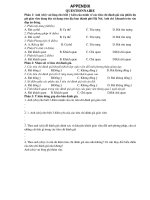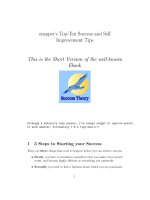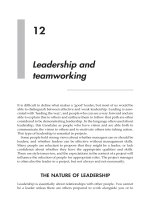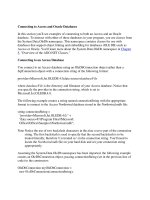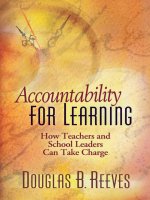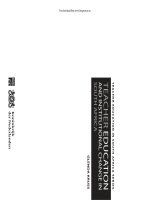Connecting teacher leadership and school improvement
Bạn đang xem bản rút gọn của tài liệu. Xem và tải ngay bản đầy đủ của tài liệu tại đây (2.04 MB, 225 trang )
FM-Murphy (Teacher).qxd
1/4/2005
10:36 AM
Page i
FM-Murphy (Teacher).qxd
1/4/2005
10:36 AM
Page ii
FM-Murphy (Teacher).qxd
1/4/2005
10:36 AM
Page iii
FM-Murphy (Teacher).qxd
1/4/2005
10:36 AM
Page iv
Copyright © 2005 by Corwin Press
All rights reserved. When forms and sample documents are included, their use is
authorized only by educators, local school sites, and/or noncommercial or nonprofit
entities who have purchased the book. Except for that usage, no part of this book may
be reproduced or utilized in any form or by any means, electronic or mechanical,
including photocopying, recording, or by any information storage and retrieval
system, without permission in writing from the publisher.
For information:
Corwin Press
A Sage Publications Company
2455 Teller Road
Thousand Oaks, California 91320
www.corwinpress.com
Sage Publications Ltd.
1 Oliver’s Yard
55 City Road
London EC1Y 1SP
United Kingdom
Sage Publications India Pvt. Ltd.
B-42, Panchsheel Enclave
Post Box 4109
New Delhi 110 017 India
Printed in the United States of America.
Library of Congress Cataloging-in-Publication Data
Murphy, Joseph, 1949Connecting teacher leadership and school improvement / Joseph Murphy.
p. cm.
Includes bibliographical references and index.
ISBN 0-7619-3199-6 (cloth) — ISBN 0-7619-8830-0 (pbk.)
1. Teacher participation in administration—United States. 2. School improvement
programs—United States. 3. Educational leadership—United States. I. Title.
LB2806.45.M87 2005
371.1′06—dc22
2004022985
This book is printed on acid-free paper.
05
06
07
08
Acquisitions Editor:
Editorial Assistant:
Production Editor:
Copy Editor:
Typesetter:
Proofreader:
Indexer:
Cover Designer:
09
10
9
8
7
Rachel Livsey
Phyllis Cappello
Laureen A. Shea
Diana Breti
C&M Digitals (P) Ltd.
Penelope Sippel
Nara Wood
Lisa Miller
6
5
4
3
2
1
FM-Murphy (Teacher).qxd
1/4/2005
10:36 AM
Page v
Contents
Preface
vii
About the Author
xi
Part I: Unpacking the Concept
1
1. Introduction to Teacher Leadership
The Starting Gate
Definitional Issues
Conclusion
3
5
8
18
2. Forces Supporting Teacher Leadership
Reconceptualizing School Organizations
Redefining School Leadership
The Changing Calculus of School Improvement
Conclusion
21
22
27
38
45
3. Teacher Leadership: A Theory in Action
Some Cautions
Embedded Logic
Conclusion
46
47
50
63
4. The Skills, Attributes, and Knowledge
of Teacher Leaders
Introductory Notes
Teacher Leadership Skills
Teacher Tasks
Conclusion
64
65
68
73
80
5. Pathways to Teacher Leadership
Role-Based Strategies
Community-Based Strategies
Conclusion
81
82
88
94
FM-Murphy (Teacher).qxd
1/4/2005
10:36 AM
Page vi
Part II: Overcoming Barriers
and Capturing Opportunities
95
6. Confronting Organizational
and Cultural Barriers
Organizational Structure
Support Systems
Culture
Conclusion
97
99
104
118
127
7. Promoting Teacher Leadership
From the Principal’s Office
Developing Relationships in Support
of Teacher Leadership
Working to Promote Teacher Leadership
Conclusion
128
129
136
141
8. Developing Teacher Leaders
The State of Preparedness
Professional Development: A General Framework
Professional Development for Teacher Leadership
Conclusion
143
144
146
150
158
9. Conclusion
Some Reminders
A Skeptical Note
A Paradox
Gaps in the Landscape
Some Caveats and Concerns
A Question of Evidence
A Note on Research
Conclusion
159
159
160
161
161
162
164
165
166
References
167
Index
191
FM-Murphy (Teacher).qxd
1/4/2005
10:36 AM
Page vii
Preface
F
or much of the last quarter century, educators, policymakers, and the general citizenry have been engaged in
an unbroken quest to understand the school improvement equation. That is, there have been ongoing efforts, sometimes systematic and often ad hoc, to identify the factors that explain school
performance and student achievement and to deepen our understanding of how they work, both as individual components and as
parts of the system of schooling.
Research over these years has consistently underscored
leadership as a critical theme in the school improvement narrative. Indeed, evidence from nearly every realm of investigation—
beginning with effective school studies through the most recent
work on comprehensive school reform—confirms leadership as
an explanatory variable in schools where all students meet ambitious achievement targets.
Over that time, our understanding of leadership has deepened
and become more complex. We have learned about the centrality of
instructionally focused leadership and the importance of transformationally anchored leadership work. We have also learned that
leadership is as much a property of the school and its culture as it
is a dimension of administrative roles. The central place of teacher
leadership in the school improvement play has been identified.
This book is designed to help the reader fully comprehend
teacher leadership as a pathway to school improvement. We
unpack teacher leadership into its core components and trace
its evolution into a more mature reform concept. We reveal
how teacher leadership fits into the larger array of school reform
initiatives. We examine the ideological and empirical seedbed in
which teacher leadership has been germinated. We investigate
the larger forces underway in education that buttress efforts to
vii
FM-Murphy (Teacher).qxd
viii
1/4/2005
10:36 AM
Page viii
CONNECTING TEACHER LEADERSHIP AND SCHOOL IMPROVEMENT
promote teacher leadership in schools. And we review the engine
or theory in action that powers the growing teacher leadership
movement.
We are not salespersons for teacher leadership. Rather, we
examine the teacher leadership phenomenon and explore how it
can function as one, albeit an important, piece of equipment in
the school improvement toolbox. By necessity, at times we assume
a critical stance, exposing flaws in the formulation of the initiative
and pointing out how, regardless of the health of the reform
model itself, the environment sometimes provides only limited
support for that potential to thrive.
In Chapter 1, we describe how emerging perspectives on teacher
leadership represent a break with prevailing views of leadership
built up around formal administrative roles. We recount how
teacher leadership is both a catalyst for and an outcome of a shift
away from a near-exclusive focus on hierarchical organizational
systems and institutional views of schooling. We also parse the
concept of teacher leadership into its prime elements and provide a
definition. We trace the history of teacher leadership over time.
In Chapter 2, we expose the three major pillars buttressing
the teacher leadership movement. We provide an analysis of the
struggle to rebuild the organizational foundations of schooling,
examining the dysfunctionalities of traditional hierarchical structures and investigating postindustrial organizational forms that
privilege collective conceptions of leadership. We highlight the
changing nature of leadership in these adaptive organizations,
capturing the general storyline as well as the implications for
those in formal leadership positions. We reveal how teacher
leadership is nourished by reform initiatives that honor professionalism and by the ongoing struggle to promote high quality
education for all youngsters.
As with all reform movements, teacher leadership is propelled
by a specific power train, one that shares multiple properties with
engines driving other professionally focused reform models, such
as school-based decision making. In Chapter 3, we peel back the
covering on that driveshaft to reveal its inner workings. We review
how teacher leadership is expected to promote professionalization
and to enhance the health of school organizations. We report how
changes in these areas are believed to link with classroom and
school improvements. We also present some caveats to hold onto
FM-Murphy (Teacher).qxd
1/4/2005
10:36 AM
Page ix
Preface
ix
while examining the hypothesized chain of benefits or theory of
action fueling the teacher leadership movement.
In Chapter 4, we provide a brief portrait of teacher leaders.
We offer a few words of caution about any attempt to craft a
generic chronicle of this complex phenomenon. We provide a
review of the limited research on factors motivating educators
to assume the mantle of teacher leader and an overview of the
central role of expertise in the teacher leadership narrative. We
present some of the bedrock principles of teacher leadership. We
provide an overview of the personal qualities that researchers
often find associated with teacher leaders, as well as the essential
skills often displayed by these educators. We also examine the
nature of the tasks performed by teacher leaders.
In Chapter 5, we examine the variety of pathways to teacher
leadership. We group these into two broad clusters: role-based
pathways and community-based approaches. We organize the narrative around a set of variables (e.g., the embedded view of leadership) that allows us to illustrate and define each of the pathways.
In Chapter 6, we examine a collection of organizational conditions and a host of professional and cultural norms that can
retard or promote the creation of a culture of shared leadership
and constrain or enhance the activities of teacher leaders. We
organize that analysis around the three broad topics of structure,
support, and culture.
In Chapter 7, we explore the special role played by the building
principal in locating, planting, and nurturing the seeds of teacher
leadership. We discuss how the development of teacher leadership
in general, and teacher leaders specifically, depends heavily on the
quality of principal-teacher relationships. We emphasize the importance of principals arriving at new nonhierarchical understandings
of leadership, including the willingness to share power widely
among their teacher colleagues. We describe how recast organizational structures can be employed in the service of teacher leadership. We outline six key functions in which principals engage to
promote teacher leadership: crafting a vision and delineating expectations for teacher leadership in the school, identifying and selecting
teacher leaders and linking them to leadership opportunities,
legitimizing the work of teacher leaders, providing direct support,
developing the leadership skill set of teacher leaders, and managing
the teacher leadership process at the school level.
FM-Murphy (Teacher).qxd
x
1/4/2005
10:36 AM
Page x
CONNECTING TEACHER LEADERSHIP AND SCHOOL IMPROVEMENT
In Chapter 8, we target professional development as a key
ingredient that needs to be energized to bring teacher leadership
to life in schools. We provide an analysis of the state of teacher
readiness to assume the mantle of teacher leadership. We explore
the elements of successful models for educating teacher leaders.
We also unpack the skills and knowledge that anchor productive
professional development experiences for teacher leaders.
In the final chapter, we introduce key issues that must be kept in
mind as we move forward in our quest to link teacher leadership and
school improvement. We raise some concerns and provide some
challenges that, if met, could significantly enhance the viability of
teacher leadership. Finally, we tease out some dilemmas associated
with the motives that inform and the structures that buttress the
teacher leadership movement, point out some thin spots in the
teacher leadership tapestry, introduce a few caveats, and outline
ways research on teacher leadership can be strengthened.
The book is designed to be of interest and use to a wide array
of educators and other decision makers. It is intended to help
teachers and principals bring teacher leadership to life in the
service of school improvement. It is designed to facilitate the
activities of educators at the district as they work on the school
improvement agenda at the system level. It is also our hope that
the teachers of future teachers and principals and those involved
with professional development for sitting school educators will
find the material herein to be helpful as we prepare colleagues
for new forms of leadership. The book should be of assistance to
school improvement researchers as they continue to deepen our
understanding of ways to create more effective schools. In a similar vein, the book should be of interest to those colleagues who
labor in the school reform vineyards, both those in the education
and policy worlds.
FM-Murphy (Teacher).qxd
1/4/2005
10:36 AM
Page xi
About the Author
Joseph Murphy is Professor of Education and Associate Dean at
Peabody College of Education at Vanderbilt University. He has also
been a faculty member at the University of Illinois and The Ohio
State University, where he was the William Ray Flesher Professor
of Education.
In the public schools, he has served as an administrator at the
school, district, and state levels, including an appointment as the
Executive Assistant to the Chief Deputy Superintendent of Public
Instruction in California. His most recent appointment was as the
founding president of the Ohio Principals Leadership Academy. At
the university level, he has served as Department Chair and
Associate Dean.
He is past vice president of the American Educational
Research Association and is the chair of the Interstate School
Leaders Licensure Consortium (ISLLC). He is co-editor of the
AERA Handbook of Research on Educational Administration (1999)
and editor of the National Society for the Study of Education
(NSSE) yearbook, The Educational Leadership Challenge (2002).
His work is in the area of school improvement, with special
emphasis on leadership and policy. He has authored or coauthored fifteen books in this area and edited another eleven. His
most recent authored volumes include The Quest for a Center: Notes
on the State of the Profession of School Administration (1999), The
Productive High School (2001), Understanding and Assessing the
Charter School Movement (2002), and Leadership for Literacy:
Research-Based Practice, PreK–3 (2003).
xi
FM-Murphy (Teacher).qxd
1/4/2005
10:36 AM
Page xii
Linda C. Holste
Premier Equestrian Person and Land Baroness
FM-Murphy (Teacher).qxd
1/4/2005
10:36 AM
Page xiii
Good intentions and even strong efforts will fail in the absence of a
strong conceptualization that informs and is informed by actions.
So far, teacher leadership strategies are not being guided by strong
conceptualization. (Fullan, 1994, p. 250)
Insofar as there are numerous examples of teacher leadership, it is
appropriate that a theoretical model of teacher leadership be developed. (Strodl, 1992, p. 10)
xiii
FM-Murphy (Teacher).qxd
1/4/2005
10:36 AM
Page xiv
01-Murphy(teacher).qxd
1/4/2005
10:38 AM
Page 1
PART I
Unpacking
the Concept
01-Murphy(teacher).qxd
1/4/2005
10:38 AM
Page 2
01-Murphy(teacher).qxd
1/4/2005
10:38 AM
Page 3
CHAPTER ONE
Introduction to
Teacher Leadership
There is significant progress being made in teacher leadership during the early years of the new century. (Katzenmeyer & Moller,
2001, p. 123)
States and local jurisdictions increasingly recognize teacher leadership as a strong and pervasive trend. (Clemson-Ingram & Fessler,
1997, p. 104)
F
or the last quarter century, the nation has witnessed a
nearly unbroken chain of initiatives to reform the
American PreK–12 educational system. These interventions have
been germinated in a wide variety of ideological seedbeds. They have
emerged in response to powerful changes underway in the larger
economic, political, and social environments in which the schooling
enterprise is nested. They have been undertaken to solve an assortment of problems and to meet a wide array of important objectives.
One significant line of work to strengthen our nation’s schools
emphasizes teachers assuming greater leadership of the organizations in which they work, or what has come to be known as teacher
leadership. While teacher leadership in America’s schools is not yet
“a broadly accepted norm” (Urbanski & Nickolaou, 1997, p. 243)
and while “teachers, in general, do not share a tradition of leadership” (Sherrill, 1999, p. 59), during the last 20 years “teacher
3
01-Murphy(teacher).qxd
4
1/4/2005
10:38 AM
Page 4
UNPACKING THE CONCEPT
leadership has become an established feature of educational
reform in the United States” (Smylie, Conley, & Marks, 2002,
p. 162). As we explain below, it differs from other improvement
efforts in important ways, especially in the theory in action or
reform engine that powers the reform. It varies in another critical
way as well. Unlike many other reform endeavors, such as charter
schools or school-based management, teacher leadership is often
an embedded concept, one that appears as a defining strand in a
larger reform effort rather than as a distinct strategy.
This book is designed to help the reader fully comprehend
teacher leadership as a pathway to school improvement. Our
jumping-off point is Snell and Swanson’s (2000) observation that
what is required in the field of “teacher leadership is a broader
conceptualization of this phenomenon” (p. 3)—that “concerted
efforts for the explication of conceptual underpinnings, implementation processes, and evaluation strategies are needed to
make teacher leadership a genuine reform initiative, rather than
another fad in the history of educational reform” (Yarger & Lee,
1994, p. 235). We also concur with Crowther, Kaagan, Ferguson,
and Hann (2002) that a “massive” amount of work is required in
“exploring the meaning of teacher leadership” (p. 18).
We are not salespersons for teacher leadership. Rather, it is
our intention to examine the teacher leadership phenomenon and
explore how it can function as one—albeit an important—piece of
equipment in the school improvement toolbox. By necessity, at
times we assume a critical stance, exposing flaws in the formulation of the initiative and pointing out how, regardless of the
health of the reform model itself, the environment sometimes
provides only limited support for that potential to thrive.
In this introductory chapter, we undertake two broad assignments. We explore prevailing concepts of leadership that often
hinder the development of teacher leadership in schools. We also
make our first pass at uncovering the meaning of this emerging
construct. In Chapter 2, we investigate the impetus for the emergence of teacher leadership on the reform landscape. Chapter 3
focuses the analytic spotlight on the theory in action or reform
engine that is powering the teacher leadership movement. After
unpacking and describing the pieces and elements of teacher
leadership, Chapter 4 presents a comprehensive model of this
change strategy. Chapter 5 addresses methods to operationalize
01-Murphy(teacher).qxd
1/4/2005
10:38 AM
Page 5
Introduction to Teacher Leadership
5
teacher leadership, moving from earlier and more discrete ideas
(e.g., creating new roles) to later, more integrated and comprehensive formulations (e.g., reconfiguring the school as a learning
community). Chapters 6 through 8 focus on getting the context
right for teacher leadership to flourish. Overcoming organizational and professional dynamics that act as a drag on the change
work is the purview of Chapter 6. Chapter 7 explores the critical
role of the principal in helping teacher leadership take root and
mature at the school level. It also offers strategies to help teachers
and principals create productive relationships in the service of
deepening the pool of leadership. Chapter 8 analyzes the significance of professional development for school staff in bringing
alternative formulations and models of leadership to life. In the
final chapter, we rescrub all the information to explore concerns
that transect the teacher leadership movement. One lens is
directed toward problems while a second is focused on the goal of
reinforcing the architecture supporting teacher leadership.
THE STARTING GATE
In the literature on educational leadership little attention is
given to the teacher as an educational leader in the school
other than in the classroom. (Brownlee, 1979, p. 119)
The assumption has been that teaching is for teachers and leading is for administrators and managers of schools. (Lynch &
Strodl, 1991, p. 2)
It is instructive to begin our analysis with a clear understanding of
traditional perspectives and models of leadership in general and
leadership in schools in particular—and to see how teacher leadership intersects with this work. Specifically, we start with the knowledge that throughout most of the last century, with its focus on
hierarchical forms and institutional dynamics, “leadership has
tended to be constructed as associated with ascribed authority and
position” (Crowther & Olsen, 1997, p. 6): “leadership traditionally
has been perceived to reside with school administrators where
power flowed downward to teachers” (Yarger & Lee, 1994, p. 226).
On the schooling scene, this has meant that (1) educational
01-Murphy(teacher).qxd
6
1/4/2005
10:38 AM
Page 6
UNPACKING THE CONCEPT
leadership has been defined in “hierarchical and positional
conceptions” (Darling-Hammond, Bullmaster, & Cobb, 1995,
p. 103), in terms of roles and the “positional authority”
(Crowther, 1997, p. 5) of principals and superintendents; (2) “the
system has not been organized to treat teachers as leaders”
(Institute for Educational Leadership, 2001, p. 3); and (3) the leadership literature, in turn, “has focused almost entirely on those in
formal school leadership positions” (Spillane, Halverson, &
Diamond, n.d., p. 7). These understandings gave rise to views of
leadership that were tightly connected to domains of responsibility,
with the assignment of “school-wide leadership to principals and
classroom leadership roles to teachers” (Clift, Johnson, Holland, &
Veal, 1992, p. 878; Crowther et al., 2002).
The significant point here is not that teachers were unconnected to leadership but that such leadership was rarely acknowledged outside the realm of the classroom, teachers’ role-based field
of authority and influence as traditionally defined (Barth, 1988a).
Because the work of teachers in terms of role and authority “has
been seen as being composed of interactions with students in
classes” (Griffin, 1995, p. 30), the expectation has been hardwired
into the structure and culture of schools “that the only job of
teachers is to teach students and to consider the classroom, at best,
as the legitimate extent of their influence” (Urbanski & Nickolaou,
1997, p. 244). “The formal authority of teachers in schools
remains carefully circumscribed. They exert extensive control over
teaching in their classrooms and departments, but their formal
influence rarely extends beyond that” (Johnson, 1989, p. 105).
This preoccupation with the hierarchical organizational
system with its tenets of separation of management (leadership)
from labor, chain of command, and positional authority has led
to the crystallization of (1) forms of schooling in which “teachers
are routed into traditional roles” (Kowalski, 1995, p. 247) and
“teacher leadership is clearly not a common contemporary condition” (Barth, 1988b, p. 134)—models in which “few people have
viewed these educators as a group in the same way as other
leaders, i.e., principals” (Hatfield, Blackman, & Claypool, 1986,
p. 20); and (2) a profession in which “teachers, even those who
are already leaders, do not see themselves as leaders” (Hart &
Baptist, 1996, p. 87). As a consequence, “there are almost no
mechanisms by which teachers can emerge as leaders for the
01-Murphy(teacher).qxd
1/4/2005
10:38 AM
Page 7
Introduction to Teacher Leadership
7
purposes of leading work on teaching, even when they have been
acknowledged as exemplary classroom teachers” (Little, 1987, p. 510).
Thus teachers are forced into “dependent roles” (Creighton, 1997, p. 5).
Not surprisingly, teachers have generally not been featured
in school reform initiatives, except in the “cog-in-the-wheel role”
(Griffin, 1995, p. 30) of implementing policy from above. They
have been afforded very limited “opportunit[ies] to effect policy
or restructure schools” (Manthei, 1992, p. 15; Lynch & Strodl,
1991) or to “participate in decision making about school improvement” (Wasley, 1991, p. 3)—“to effect meaningful change outside
their classrooms or departments” (Johnson, 1989, p. 104). While
the need for leadership has been a central ingredient in the school
change and school improvement literature, consistent with the
analysis above, historically that leadership has been associated
with those in roles with positional authority over teachers (Heller
& Firestone, 1994; Leithwood, Jantzi, Ryan, & Steinbach, 1997;
Smylie, Conley, & Marks, 2002). Indeed, it is proposed that much
of the reform activity of the last quarter century has actually
solidified the traditional roles of administrators as leaders and
teachers as followers (Crowther, 1997).
The theme of teacher leadership as a “seriously underdeveloped topic” (Crowther & Olsen, 1997, p. 6), both conceptually and
in practice, is ribboned throughout this book. So too are analyses of
the costs to the educational system and to teachers of the overreliance “on the accepted body of thought on educational leadership” (Crowther et al., 2002, p. 23) and prevailing models of
schools as hierarchical organizations, especially theories that originate in the corporate and managerial system. We proceed from
Suleiman and Moore’s (1997) position that “the false assumption
that teaching is for teachers and leading is for administrators has
operated to the inutility of the public schools for a long time” (p. 6),
that the sole emphasis on formal school leaders “at the center of
educational leadership is ill directed” (Crowther et al., 2002, p. 49)
and has real costs in terms of schooling outcomes.
We commence also from the proposition that “teacher leadership is essential to change and improvement in a school” (Whitaker,
1995, p. 76; Killion, 1996), that “genuine, long-lasting school
change initiatives must derive from and involve teachers” (Kelley,
1994, p. 300), and that without teachers’ “full participation
and leadership, any move to reform education—no matter how
01-Murphy(teacher).qxd
8
1/4/2005
10:38 AM
Page 8
UNPACKING THE CONCEPT
well-intentioned or ambitious—is doomed to failure” (Lieberman &
Miller, 1999, p. xi). In short, we argue for the necessity of challenging
the underlying assumptions about existing roles for teachers and
school administrators (Barth, 2001; Foster & Suddards, 1999;
Rallis, 1990; Sergiovanni, 1991a, 1991b).
The scaffolding on which we construct our understanding of
leadership is forged from “multiple sources and persons”
(Crowther, 1997, p. 7). It arises in part from the stockpile of
material on leadership roles but is inclusive of more than traditional administrative roles (Miller, 1992). That is, we advance
beyond the view of “educational leadership as the domain of either
a particular stratum of the educational system or the individuals
within that stratum” (Crowther, 1997, p. 6). Our scaffolding is also
erected, however, from our best understandings of leadership as
(1) an organizational property, (2) a function or process, (3) an outgrowth of expertise, (4) an activity of a group, and (5) a dynamic of
community, understandings that move us away from what O’Hair
and Reitzug (1997) label “conventional leadership” (p. 65) and
that permit the concept of teacher leadership to be positioned on
center stage in the leadership play—insights that promote “a new
type of leadership” (Katzenmeyer & Moller, 2001, p. 82) or “a new
paradigm of leadership—one that recognizes the central place of
teachers” (Crowther et al., 2002, p. 27).
DEFINITIONAL ISSUES
The issue of teacher leadership is devilishly complicated. And
it doesn’t help matters that the phrase itself is frustratingly
ambiguous. (Wigginton, 1992, p. 167)
Even now, we are a long way from a common understanding
of teacher leadership. Confusion about definitions . . .
abound. (Katzenmeyer & Moller, 2001, pp. 4–5)
An Organizational Focus
There are almost no mechanisms by which teachers can
emerge as leaders for purposes of leading work on teaching,
even when they have been acknowledged as exemplary classroom teachers. (Little, 1987, p. 510)
01-Murphy(teacher).qxd
1/4/2005
10:38 AM
Page 9
Introduction to Teacher Leadership
9
Analysts emphasize either a “two-level concept” (Keedy, 1999,
p. 787; Strodl, 1992) or a three-tiered model of teacher leadership
(Murphy, 1991). Specifically, leadership can be linked to influence
in three broad domains or “zones” (Ingersoll, 1996, p. 162):
autonomy of teachers in their classrooms, the ability to shape
school policies and practices, and control of the machinery of the
profession writ large (e.g., licensure, certification) (Ingersoll, 1996;
McCarthy & Peterson, 1989; Sizer, 1984). Leadership in each zone
is seen somewhat differently; for example, it is often asserted that
“teaching children and adolescents is quite different from leading
and coaching teachers” (Berry & Ginsberg, 1990, p. 618).
While, by necessity, we touch on activity in zone one above, the
focus of this book is on teacher leadership beyond the classroom,
primarily at the school level. Our attention here does not gainsay
the fact that “a classroom including a group of students and their
class teacher is in itself a small social organization” (Cheng, 1994,
p. 54), nor does it deny the importance of teacher leadership in
classrooms (Berliner, 1986). Indeed, considerable effort has been
devoted to describing student-based teacher leadership (see, for
example, Cheng, 1994; Larkin, 1973; Reinoso, 2002; Vertiz,
Fortune, & Hutson, 1985). Rather, it is simply an acknowledgment
that our charge is to explore what is known about teacher leadership activities in the larger organization in which they work.
Newness
To make matters more complicated, teacher leadership is a
fairly recent phenomenon. (Yarger & Lee, 1994, p. 233)
As we concentrate on the nature of teacher leadership beyond
the classroom, certain inescapable conclusions emerge. To begin
with, we find that teacher leadership defined in this way is a relatively new idea “in both research and practice circles” (Lieberman,
1992, p. 160). Certainly, prior to 1985 it is a difficult theme to
observe, even employing powerful analytic lenses; “teaching and
leadership [had] not been dealt with together much” (Lynch &
Strodl, 1991, p. 2) before then. Indeed, given the overview in the
previous section, one can see quite clearly why “the possibility
that leadership might be a function of the work of teachers has
only recently begun to be accorded serious consideration”
(Crowther & Olsen, 1997, p. 7).
01-Murphy(teacher).qxd
10
1/4/2005
10:38 AM
Page 10
UNPACKING THE CONCEPT
Because scholarship in the area “has only begun to emerge”
(Silva, Gimbert, & Nolan, 2000, p. 779), there is “no wellestablished body of literature” (Wasley, 1991, p. 9) on teacher
leadership and consequently “not much is known” (Fay, 1992a,
p. 4) about the concept. Thus, even while the idea appears to have
“burst upon the scene” (Lieberman, 1992, p. 160) and is something of a “hot topic” (Smylie, 1996, p. 573; Boles & Troen, 1996)
today, it is instructive to remember that teacher leadership outside
the classroom has rather shallow roots.
An Element in School Reform Models
The second wave of educational reform . . . raised interest in
new roles that give teachers more leadership responsibility.
(Heller & Firestone, 1994, p. 1)
As we touched on in the first section and re-emphasize here,
teacher leadership initially rode into play on the back of various
broad-based reform movements, for example, school-based management and professionalization (Murphy, 1990a). Thus, while
the concept sometimes assumed the leading role, it has more often
been a supporting actor. For example, it is one of a series of critical
elements in most models of site-based decision making (Monson &
Monson, 1993; Murphy & Beck, 1995; Smylie, 1995).
At the same time, the idea of teacher leadership is often “caught
in the collision . . . between two strategies for achieving reform: one
resting on heightened involvement and commitment of participants and one relying on intensified control of participants’ work”
(Little, 1995, p. 50; Murphy, 1990a)—and more recently, we would
add, the reliance on market forces to fuel improvement (Murphy,
1996, 1999, 2000c). It is also often difficult to tease out the extent
to which teacher leadership is a causal variable in the school reform
algorithm or a product of reform movements such as learning organizations and communities of practice.
Complexity
I was struck . . . at how enormously complex teacher leadership roles are as they play out in practice. (Wasley, 1991,
p. 154)
